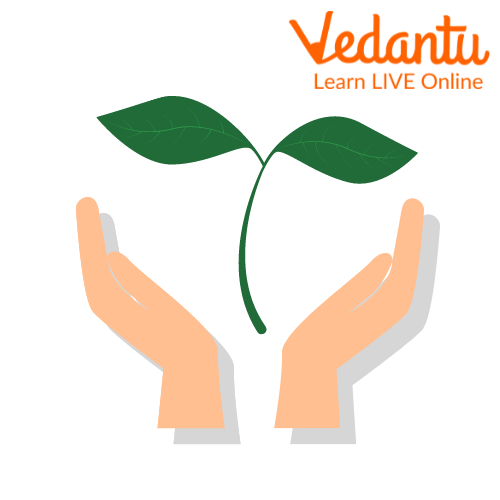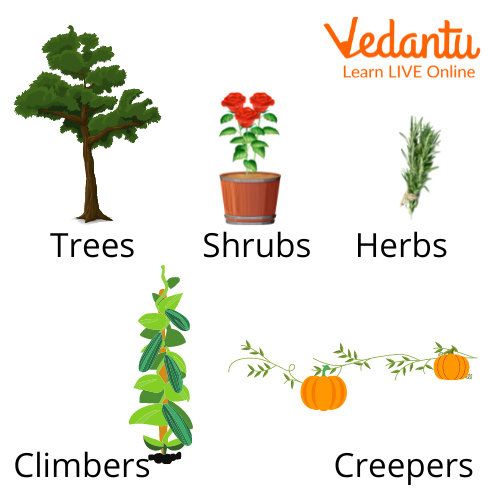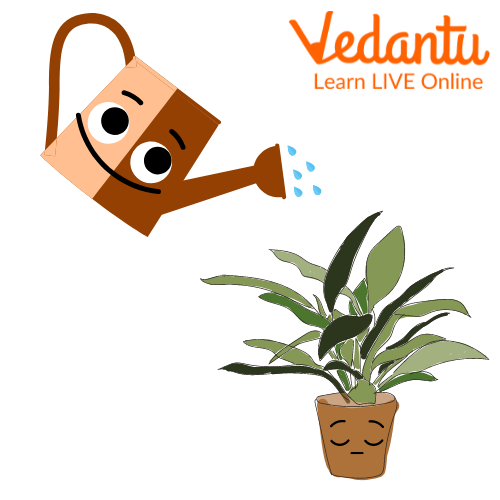




Types of Plants for Kids
A plant is defined as a living thing that grows on the earth. The parts of the plant include a stem, leaves, and roots. The plant provides food, fibre, shelter, medicine, and fuel. Let us understand what are plants in more detail.
Green plants produce energy for all organisms. They produce oxygen that helps us in the process of breathing and is essential for the survival of life. The different types of plants for kids are herbs, shrubs, trees, climbers, and creepers. In this article, we are going to learn about what are plants for kids and more information on plants for kids.

Plants for Kids
What are the Common Types of Plants?
The different types of plants for kids are as follows.
Herbs
Herbs are plants that provide us with fragrant or aromatic properties. This can be used to add extra flavour to food. Examples of herbs are Basil, parsley, rosemary, thyme, and dill.
Shrubs
The shrub is any woody plant with several stems and no dominant property. The shrub is usually less than 3 m tall. It may be called a bush when the shrub is much-branched and dense in this condition.
Trees
The tree is defined as a long-lived woody plant with a single, usually tall main stem with few or sometimes no branches on its lower part.
Climbers
The climbers are plants with long, flexible climbing stems that are rooted in the ground and usually have long dangling branches.
Creepers
The creepers are the plant that grows upon or just beneath the surface of the ground or upon any other surface, sending out the rootlets from the stem,

Types of plants
Facts About Plants for Kids
A few interesting facts about plants for kids are as follows:
The plants turn light from the Sun into food required for their growth.
Plants also need water and nutrients from the soil and the carbon dioxide that they take from the air.
The animals can eat plants so that they can use the food the plants created for their growth too.
The animals cannot turn the sun's energy into food. Hence they only get this energy by eating plants or by eating other animals.
The giant redwood tree is the biggest type of plant on earth.
Many plants reproduce by creating their seeds using pollen from other plants of the same type.
The plants use their flowers to attract other insects to carry pollen from one plant to the next.
The flowers have a sugary liquid known as the nectar that the insects eat when they are on the flower.
However, some plants spread their seeds by letting them float through the wind.
Not every plant gets all its energy from sunlight.
Plant adaptation is a phenomena in which a species develops any special features that improve its chances of survival. The adaptations evolve over a long period, and they are inheritable, meaning they are passed onto offspring.
The plants can be big giant trees or small, tiny patches of moss. With the help of a process called photosynthesis, plants produce their own food. During this process, the plants convert the light from the sun into food. The plants use a process called photosynthesis to turn sunlight into food in their leaves.
They use this produced food to grow. For the growth of plants, they also need water and nutrients that they take from the soil with the help of their roots and carbon dioxide that they absorb from the air.

Watering of Plant
Summary
So, this brings us to the end of this article where we have discussed all the information on plants for kids like their types as well as their characteristics. Plants are living things that grow from the soil and turn light from the Sun into food. The plants can be big giant trees or small, tiny patches of moss. With the help of a process called photosynthesis, plants produce their food.
The green plant produces the primary food for all organisms. The oxygen is released during the process of food production. Herbs, Shrubs, Trees, Climbers, and Creepers are different types of plants. Many plants reproduce by creating their seeds using pollen from other plants of the same type. The plants use their flowers to attract other insects to carry pollen from one plant to the next.
FAQs on What are Plants for kids?
1. What is a plant in simple words for kids?
A plant is a living thing that usually grows in the ground and stays in one place. Like people and animals, plants need food, water, and air to live. Most plants are green and are unique because they can make their own food using sunlight. Examples you see every day include big trees, colourful garden flowers, and the grass in a park.
2. What are the main parts of a plant and what do they do?
Most plants have several important parts, each with a special job to help the plant live and grow. The main parts are:
- Roots: These grow under the ground. They act like a straw to drink water from the soil and also hold the plant firmly in place.
- Stem: This is the strong body of the plant that supports it. It acts like an elevator, carrying water and food to all other parts.
- Leaves: These are usually green and work like a kitchen. They use sunlight, air, and water to make food for the plant.
- Flower: This is often the most colourful part of a plant. The flower's main job is to help the plant make seeds to grow new plants.
- Fruit: The fruit grows from the flower and protects the seeds inside. We love to eat fruits like apples, mangoes, and bananas!
3. What are the different types of plants? Can you give examples?
Plants come in many different shapes and sizes. We can group them into five main types:
- Trees: These are very big and strong plants with a thick, woody stem called a trunk. Examples include the Banyan tree and Mango tree.
- Shrubs: These are smaller than trees and have many hard, woody stems that grow from the ground. Examples are the Rose plant and Hibiscus plant.
- Herbs: These are very small plants with soft, green stems. Examples include Mint (pudina) and Coriander (dhania).
- Climbers: These plants have weak stems and need support from walls or other plants to climb up. Examples are the Money plant and Pea plant.
- Creepers: These plants also have weak stems but they spread out and grow along the ground. Examples are Pumpkin and Watermelon plants.
4. How do plants make their own food?
Plants are amazing because they are their own chefs! They make their food in their leaves using a process called photosynthesis. To do this, they need three main ingredients: sunlight from the sun, water which their roots absorb from the soil, and a gas called carbon dioxide which they take from the air. When they combine these, they create a sugary food to help them grow and release oxygen, which is the gas we need to breathe.
5. Why do plants need sunlight to grow?
Plants need sunlight because it is the main source of energy for them to make their food. The green colour in their leaves, called chlorophyll, traps the sunlight. Without sunlight, a plant cannot perform photosynthesis, which means it cannot create the food it needs to grow, build strong stems, or produce flowers and fruits. This is why plants kept in a dark room will become weak and yellow.
6. Why are plants so important for us and all living things?
Plants are vital for all life on Earth for several key reasons. First, they produce the oxygen that we and other animals need to breathe. Second, they are the primary source of food, providing us with fruits, vegetables, and grains. They also give us important materials like wood for shelter, cotton for clothes, and ingredients for medicines. Finally, they provide homes and shelter for countless birds, insects, and animals.
7. What are the four main things a plant needs to grow strong and healthy?
Just like you need certain things to be healthy, a plant needs four essential things to grow well. These are:
- Sunlight: To provide the energy to make food.
- Water: To stay hydrated and help move nutrients through the stem.
- Air: To get carbon dioxide for making food and oxygen for respiration.
- Soil: To get support for its roots and essential nutrients to stay strong and healthy.
If any one of these is missing, the plant will struggle to survive.









